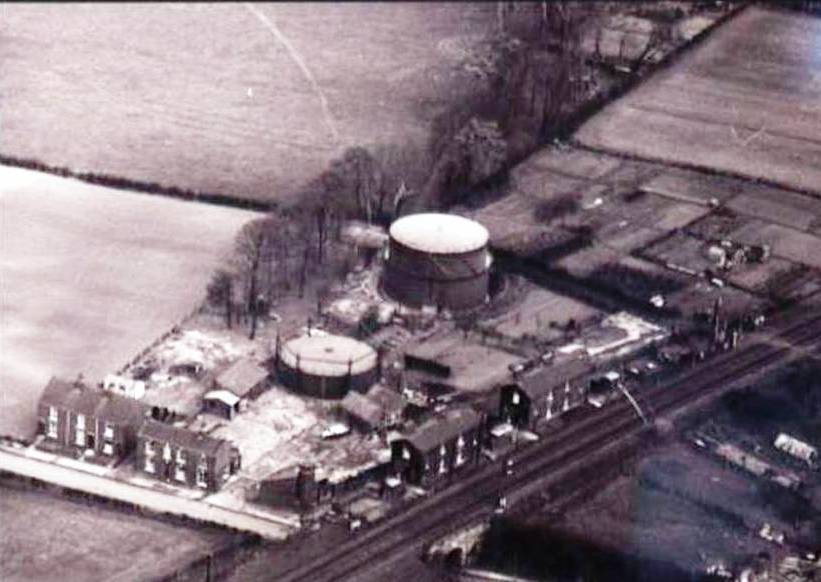
Garforth gasworks and gasometers where the Barwick road runs under the railway.
(Copyright -'Skyviews')
It was at the meeting of Barwick-in-Elmet Parish council (PC) held on Monday, 2 June, 1913, that the Clerk presented a letter from the Garforth Gas Co. Ltd. Although the actual content of this letter is not known in detail, much can be assumed by the immediate reactions of the councillors. The Clerk of the council was instructed to send a copy to the Tadcaster Rural District Council (TRDC) - "strongly protesting against its highways authority allowing a private gas company to break up the roads and lay gas mains in the Barwick Parish" - seeing that at some future time the PC may want to provide this itself.
I think that it was the gas company's intention to 'encroach' a very short distance (i.e. a few hundred yards north of Nanny Goat Lane) into the Barwick Parish, when laying a gas main to Aberford. It would also appear that an amicable solution was eventually reached as there is no further reference in the council minutes.
In April 1914, the PC received a further letter from the Garforth Gas Co. Ltd suggesting a meeting to discuss the possibility of supplying gas to Barwick - as pipes had been laid within a mile of Barwick village! The gas company was prepared to supply gas to 'ordinary' customers at 3s.9d. per 1000 cubic feet and to 'slot' customers at 4s.2d. per 1000 cubic feet. ('Ordinary' customers were those who were trusted to pay in arrears, whereas 'slot' customers were those who were required to pay in advance.) In addition 'ordinary' customers would also be charged 9d. a quarter as meter rent. Three lights would be fixed in any house, together with the piping and a fork bracket, free of charge.
Following a discussion with the directors of the gas company (who were in attendance), the councillors favourably considered the offer (For-6, Against-0, 2 members remained neutral).
One month later, the councillors received a letter confirming the details but the gas company appeared to have reneged on the 'free' fittings. There was much further correspondence between the two parties regarding this apparent shortfall of the original offer. Eventually the gas company acknowledged that the misunderstanding was most regrettable but the course they were adopting had already been adopted in both Garforth and Aberford and the company decided that it was imperative that any contract with Barwick should be made on the same basis. Subsequently the PC reluctantly agreed the revised terms. Unfortunately the PC minutes do not disclose the date(s) when the gas main/mains were actually laid but it was most likely to have been shortly before World War I.
In September 1914 the PC agreed to form a sub-committee, consisting of all the Barwick Ward councillors, to draw up a scheme of public lighting for part of the Barwick Ward and to submit the same to a Parish meeting. The Lighting and Watching Act of 1833 had prompted this action as the Act included a provision for allowing parish vestries (subsequently parish councils) to appoint inspectors and for a paid night-watch. (Full details of this act, all 34 pages of A4, are now deposited in the Society's resource centre and may be viewed by arrangement.)
I can find no further reference to gas supply until July 1937 when the PC formed a sub-committee to consider gas / electric street lighting for the whole of the parish.
Following a meeting in September 1937, the Barwick councillors agreed to go ahead with street lighting in Barwick but it was noted that the Scholes councillors were not in favour of providing street lighting in Scholes. Two months later the PC held a poll of the Barwick electors - the result of which showed that there were 259 votes in favour and 38 votes against - a majority of 221. The PC immediately passed the resolution to pay the sum of £60.10s.0d. by means of a special Barwick Ward rate for the purpose of the provision of street lighting.

ALAN SENIOR |